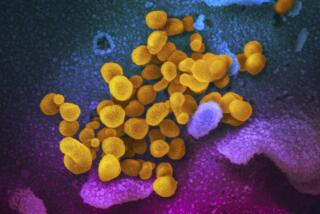Study Downplays the Health Risks From Secondhand Smoke
- Share via
Secondhand smoke does not appear to increase the risk for lung cancer and heart disease, according to a study in the British Medical Journal that was partially funded by the tobacco industry.
The study was quickly criticized by the American Cancer Society and other health groups as misleading and unreliable.
“We are appalled that the tobacco industry has succeeded in giving visibility to a study with so many problems it literally failed to get a government grant,” said Dr. Michael J. Thun, the society’s national vice president of epidemiology and surveillance research. “This study is neither reliable nor independent.”
The study’s lead author, epidemiologist James Enstrom of UCLA’s School of Public Health, said his findings were solid and the tobacco industry did not influence the research.
“There should at least be a reexamination of some of the previous summaries of the data to incorporate these findings,” he said.
Enstrom and co-author Geoffrey C. Kabat of the State University of New York at Stony Brook reviewed data for 118,094 Californians who had enrolled in an American Cancer Society cancer prevention study in 1959. The Californians were a subset of the participants in the original study, which recruited people in 25 states.
Enstrom and Kabat focused their work on 35,561 people who had never smoked but had spouses who did. The scientists reviewed the histories of the participants from 1960 to 1998 and found no significant increase in their death rate for coronary heart disease, lung cancer and chronic obstructive pulmonary disease.
But the study contradicted the conclusions of a variety of other studies. The World Health Organization and other health agencies have concluded that secondhand smoke carries heightened risk for such diseases, on the order of a 20% increased risk for lung cancer and a 30% increase for heart disease.
The American Cancer Society and several scientists said the study was flawed in several ways. For instance, researchers examined only 10% of the people originally enrolled in the American Cancer Society study. Additionally, in the early years of the study, people were exposed to secondhand smoke in many other places than the home, such as movie theaters, restaurants and the workplace. This would have the effect of dwarfing the effects of secondhand smoke in the home.
They said it also would be hard to reliably know how much smoke the subjects had been exposed to in the home, since information on the smoking status of spouses wasn’t collected after 1972. Many spouses could have quit or started smoking or died in the interim.
“We have one very flawed study that does not find an association,” said Dr. Jonathan Samet, professor and chair of epidemiology at the Johns Hopkins University Bloomberg School of Public Health. “It flies in the face of so much evidence and so much scientific understanding that it just doesn’t contribute.”






